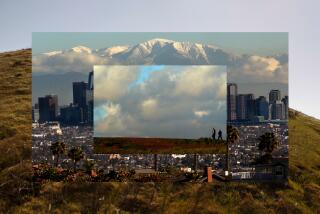Eureka! Dunes to Climb
- Share via
Between the Owens Valley and Death Valley, isolated and often-overlooked Eureka Valley holds many surprises, chief among them, the Eureka Dunes. The dunes, formerly known as the Eureka Dunes National Natural Landmark and administered by the U.S. Bureau of Land Management, were added to the expanded Death Valley National Park in 1994.
The dunes occupy the site of an ancient lake bed, whose shoreline can be identified to the northeast of the dunes. The onetime flat lake bed northwest of the dunes sometimes captures a little surface water.
The neighboring Last Chance Mountains gets its fair share of the meager rains that fall in these parts--meaning the dunes are (relatively) well watered. Rain percolates downward, later nurturing about 50 different dune plants even in the driest of years. Three species of flora occur nowhere else: Eureka Dunes milk vetch, Eureka dune grass and the showy, large white flowers of the Eureka Dunes evening primrose.
Like their cousins, the Kelso Dunes in Mojave National Preserve, the Eureka Dunes “boom.” Low vibrational sounds are created when the wind-polished, well-rounded grains of sand slip-slide underfoot. The booming, which has been compared to the low-altitude airplane and a Tibetan gong, is louder in the Kelso Dunes.
The dunes, California’s highest at nearly 700 feet, are also impressive for their height.
The trail-less walking is strictly free-form--up and across. If you get to the top of the island of sand, you’ll get a unique vista of Eureka Valley and the many mountains that surround it: the Last Chance Range to the northeast, the Saline Range to the west, the Inyo Mountains to the southwest.
Directions to trail head: From the entrance station opposite Grapevine Campground, continue north on North Highway a short distance to a fork. The right fork leads to Scotty’s Castle, but you continue toward Ubehebe Crater, 2.8 miles, then turn right onto dirt Death Valley Road. Drive 21 miles northwest to Crankshaft Junction. Bear left, continuing on Death Valley Road, which heads southwest up and over the Last Chance Range. (A few miles of the road through Hanging Rock Canyon are paved, the rest dirt.) After 12.3 miles, turn left (south) onto South Eureka Road and travel 10.7 miles to the north end of the dunes and a road fork.
An ungraded road goes east to the north side (near interpretive signs) and primitive campsites. You can safely drive straight ahead to the northwest corner of the dunes. Avoid getting stuck by staying on the established roads.
(BEGIN TEXT OF INFOBOX / INFOGRAPHIC)
Eureka Dunes Trail
WHERE: New, northen addition to Death Valley National Park.
DISTANCE: 1 to 5 miles round trip.
TERRAIN: Massive white sand dunes, 1/2-mile wide, 3 miles long.
HIGHLIGHTS: Tallest California sand dunes; a photographer’s dream. Kids love it here.
DEGREE OF DIFFICULTY: Easy to moderate.
FOR MORE INFORMATION: Death Valley National Park, Death Valley, CA 92328; tel. (619) 786-2331.
More to Read
Sign up for The Wild
We’ll help you find the best places to hike, bike and run, as well as the perfect silent spots for meditation and yoga.
You may occasionally receive promotional content from the Los Angeles Times.






